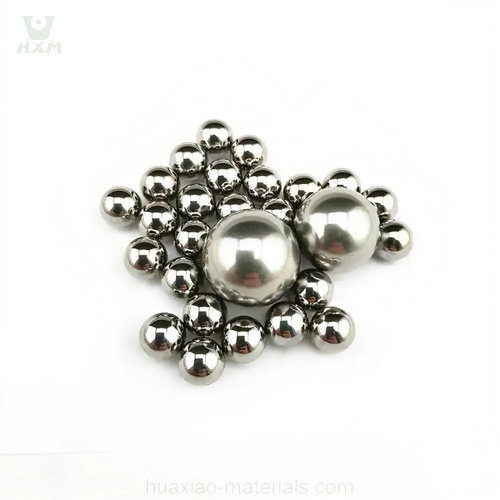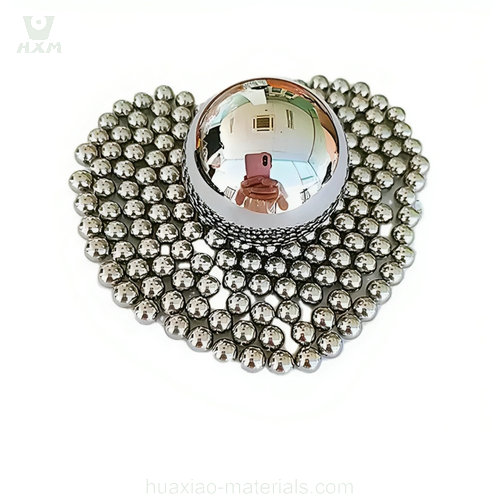52100 ball bearing steel
52100 ball bearing steel is a high-carbon, chromium alloy used in ball bearings, offering exceptional hardness and wear resistance. It ensures smooth and reliable bearing performance in various applications.


52100 ball bearing steel is a high-carbon, chromium alloy used in ball bearings, offering exceptional hardness and wear resistance. It ensures smooth and reliable bearing performance in various applications.


52100 ball bearing steel, also known as AISI 52100, is a high-carbon chromium alloy steel that is commonly used for manufacturing ball bearings. Its chemical composition plays a crucial role in its excellent wear resistance and durability. Here’s the key chemical composition of 52100 ball bearing steel:
Carbon (C): 0.98% – 1.10%——Carbon provides hardness and wear resistance to the steel, making it suitable for bearing applications.
Chromium (Cr): 1.30% – 1.60%——Chromium enhances the steel’s hardenability and resistance to corrosion. It also contributes to the formation of chromium carbides, which improve wear resistance.
Manganese (Mn): 0.25% – 0.45%——Manganese improves hardenability and tensile strength while reducing the risk of brittleness.
Silicon (Si): 0.15% – 0.35%——Silicon enhances the steel’s strength and elasticity.
Phosphorus (P): ≤ 0.025%——Phosphorus is kept low to maintain the steel’s purity and prevent brittleness.
Sulfur (S): ≤ 0.025%——Sulfur is also kept low to improve the steel’s machinability.
Chromium (Cr): 1.30% – 1.60%——Chromium enhances hardenability and wear resistance.
Nickel (Ni): ≤ 0.25%——Some grades of 52100 may contain small amounts of nickel for improved toughness.
Copper (Cu): ≤ 0.25%——Copper may be present in trace amounts, mainly to improve corrosion resistance.
These chemical elements work together to give 52100 steel its characteristic hardness, wear resistance, and load-bearing capabilities, making it an excellent choice for the production of ball bearings and other high-stress, high-friction components.
52100 ball bearing steel is renowned for its exceptional hardness and wear resistance, which are essential attributes for its primary application in ball bearings. Here are the key characteristics related to hardness, wear resistance, and performance in high-load environments:
Overall, 52100 ball bearing steel is prized for its exceptional hardness and wear resistance, making it a preferred choice for critical applications where durability and reliability are paramount, such as in ball bearings used in machinery, automotive components, and aerospace systems.
52100 ball bearing steel is widely used in various mechanical engineering applications due to its exceptional hardness, wear resistance, and load-bearing capabilities. Here are some common areas where 52100 steel finds extensive use:
Ball Bearings: This is the primary application for 52100 steel. It is used to manufacture the balls and races in ball bearings, ensuring smooth rotation and reduced friction in a wide range of machinery and equipment, including automotive components, industrial machinery, and aerospace systems.
Automotive Industry: 52100 steel is used in the production of automotive wheel bearings, transmission bearings, and engine components. Its durability and resistance to wear are critical for ensuring the reliability of vehicles.
Aerospace: In the aerospace industry, 52100 steel is employed for various components, including aircraft landing gear bearings, control systems, and jet engine components. Its high strength and fatigue resistance make it suitable for handling extreme conditions.
Industrial Machinery: Machinery such as conveyor systems, pumps, and compressors often utilize 52100 steel in their bearings and rotating parts. Its ability to withstand heavy loads and provide smooth operation contributes to the efficiency and longevity of these machines.
Hand Tools: Certain hand tools, like high-quality ball bearings in hand drills, rely on 52100 steel to ensure precision and durability. It helps reduce friction, extend tool life, and enhance performance.
Bicycle Bearings: In the bicycle industry, 52100 steel is commonly used in the production of wheel and headset bearings. It contributes to smoother rides, lower maintenance requirements, and improved overall performance.
Firearms: 52100 steel is occasionally used in firearm components like trigger mechanisms and bolt carrier groups due to its strength and resistance to wear.
Roller Bearings: While roller bearings are often made from different materials, 52100 steel is occasionally used for cylindrical roller bearings and tapered roller bearings in applications requiring high load capacity.
Oil and Gas: Some oil and gas drilling equipment rely on 52100 steel for its strength and durability in harsh drilling environments.
Marine Applications: In marine environments, where corrosion resistance is crucial, 52100 steel is used selectively in bearings and components that do not require extensive exposure to seawater.
Overall, 52100 ball bearing steel plays a vital role in numerous industries and applications where the ability to handle heavy loads, resist wear, and maintain precision are essential requirements for the success and reliability of mechanical systems.
52100 ball bearing steel offers several advantages when compared to other bearing steels, making it a preferred choice in various applications:
Exceptional Hardness: 52100 steel has a high hardness level, typically in the range of 58-65 HRC (Rockwell Hardness). This hardness provides excellent wear resistance, ensuring extended service life in demanding environments.
Superior Wear Resistance: Thanks to its hardness and fine-grain structure, 52100 steel exhibits exceptional wear resistance, reducing the need for frequent replacements and maintenance.
High Load Capacity: The combination of hardness and toughness allows 52100 steel to withstand heavy radial and axial loads without deformation or damage, making it suitable for high-load applications.
Low Friction: The inherent smoothness of 52100 steel surfaces, particularly in ball bearings, results in lower friction. This not only improves energy efficiency but also reduces heat generation and wear.
Excellent Fatigue Resistance: 52100 steel is known for its excellent fatigue resistance, ensuring the durability of components subjected to cyclic loading. This property is crucial in applications like ball bearings.
Dimensional Stability: It maintains its dimensional stability under load and at various temperatures, contributing to the precision and accuracy of machinery and equipment.
Fine-Grain Structure: Its fine-grain structure enhances its ability to maintain performance under stress and ensures consistent mechanical properties throughout the material.
Corrosion Resistance: While not as corrosion-resistant as stainless steels, 52100 steel can be treated to improve its resistance to environmental corrosion, making it suitable for many applications.
High Temperature Performance: It retains its hardness and strength at elevated temperatures, allowing it to operate effectively in applications where heat resistance is required.
Versatility: 52100 steel’s versatility extends to a wide range of applications, from ball bearings in automotive components to critical aerospace components.
Proven Track Record: It has a long history of successful use in various industries, which attests to its reliability and performance.
While 52100 steel offers these advantages, it’s essential to note that material selection should consider specific application requirements, including environmental conditions, load capacity, and corrosion resistance. In some cases, other bearing steels or materials, such as stainless steels or ceramic bearings, may be more suitable for specialized applications.
The heat treatment process of 52100 ball bearing steel is crucial to achieving its desired mechanical properties. This steel undergoes a series of heat treatment steps, including annealing, hardening, and tempering. Here’s a breakdown of the heat treatment process and its effects on the material’s properties:
Effect: Annealing relieves internal stresses, refines the grain structure, and improves machinability. It results in a softer, more workable material.
Effect: Hardening transforms the steel into a hardened and highly wear-resistant state, increasing its hardness significantly.
Effect: Tempering reduces the hardness to a more manageable level while improving toughness, ductility, and resistance to brittle fracture. This step optimizes the balance between hardness and toughness, making the steel suitable for bearing applications.
Overall, the heat treatment process for 52100 bearing steel allows for precise control over its mechanical properties. Properly treated, it exhibits excellent hardness, wear resistance, and fatigue resistance, making it ideal for use in demanding applications such as ball bearings, rollers, and other high-load components in machinery and automotive industries.
52100 ball bearing steel is available in various specifications and sizes to meet the diverse needs of different applications. Below are some common specifications and sizes for 52100 ball bearing steel:
These sizes and specifications can be tailored to meet specific project requirements. Additionally, manufacturers and suppliers often provide customized cutting and machining services to produce components with precise dimensions and tolerances, ensuring they are suitable for various bearing applications in machinery, automotive, aerospace, and more.
When choosing a supplier for 52100 ball bearing steel, several key factors should be considered to ensure that you obtain high-quality material for your specific needs. Here are the important factors to keep in mind:
By carefully evaluating these factors, you can choose a reliable supplier of 52100 ball bearing steel that meets your quality, quantity, and service requirements.
Copyright@2023 Huaxiao Metal Corporation Limited . All rights are reserved
WhatsApp us
Feel free to contact us!
If you need our products, please leave us a message with the specific specifications and quantity through the window on the right!
Reply within 24 hours